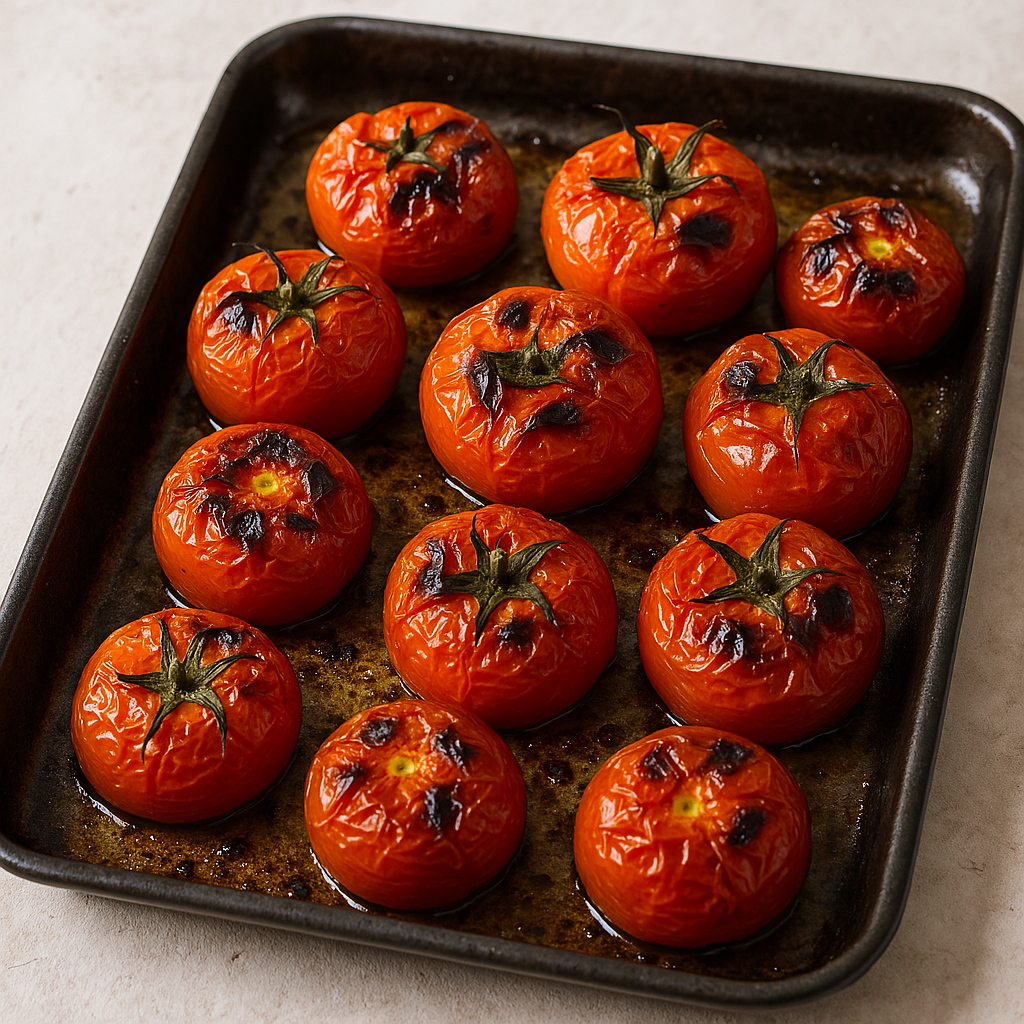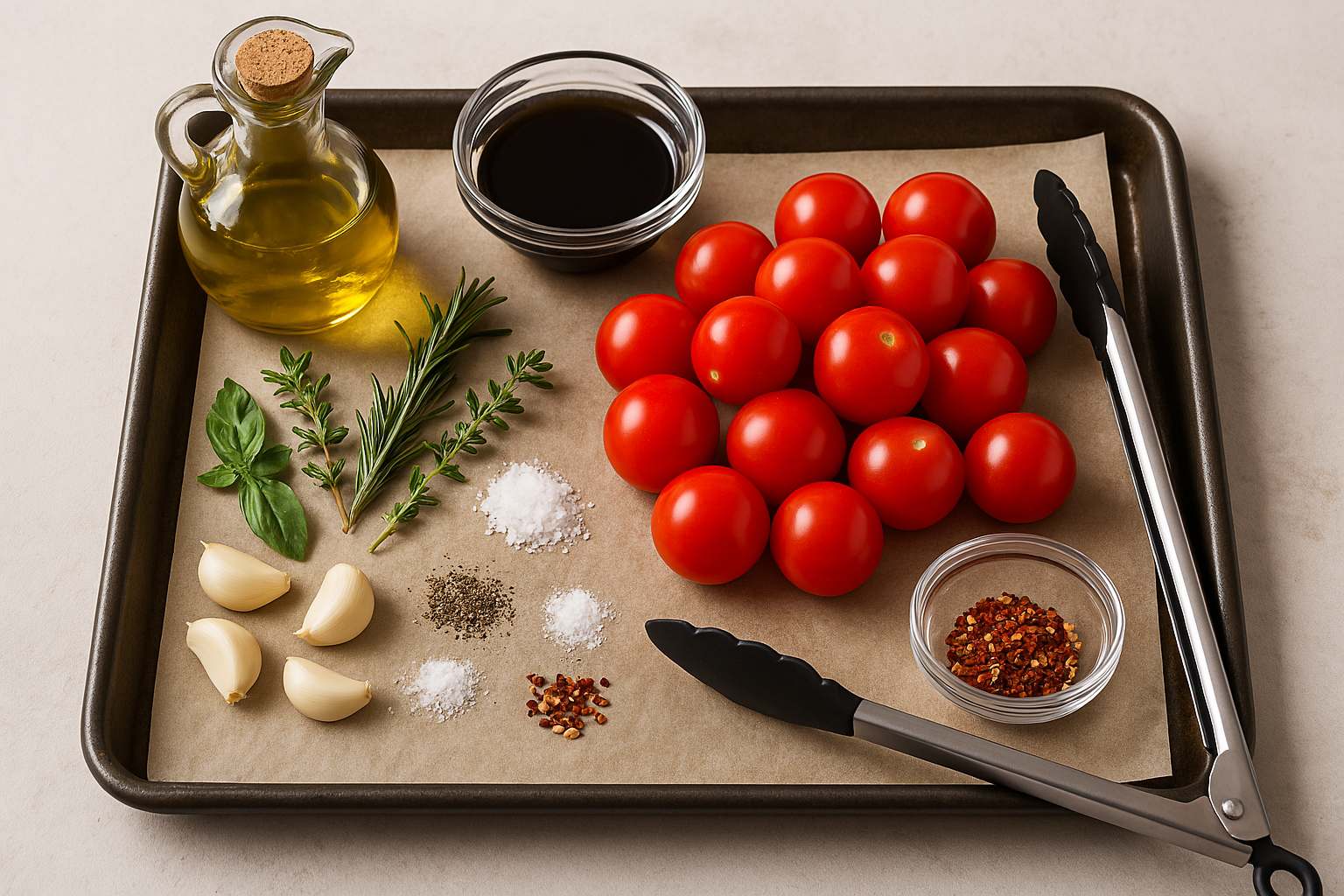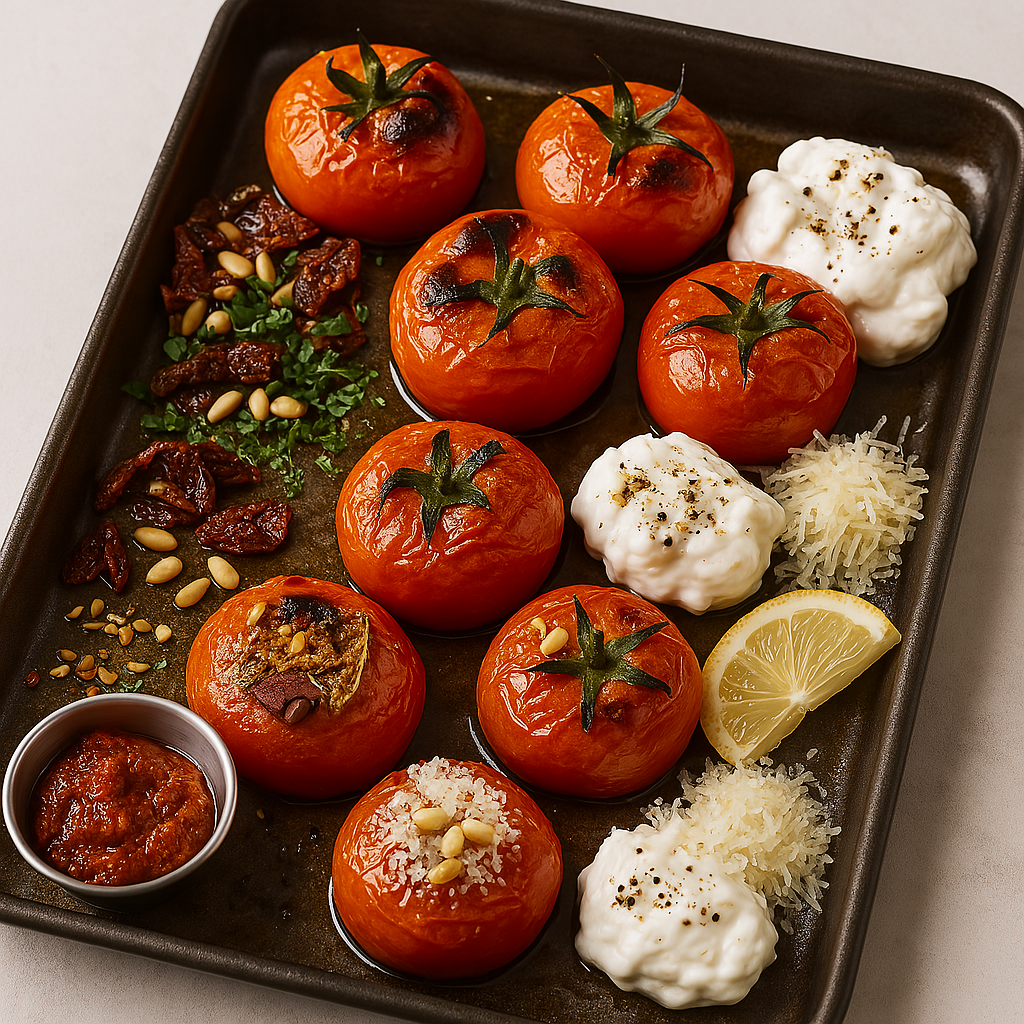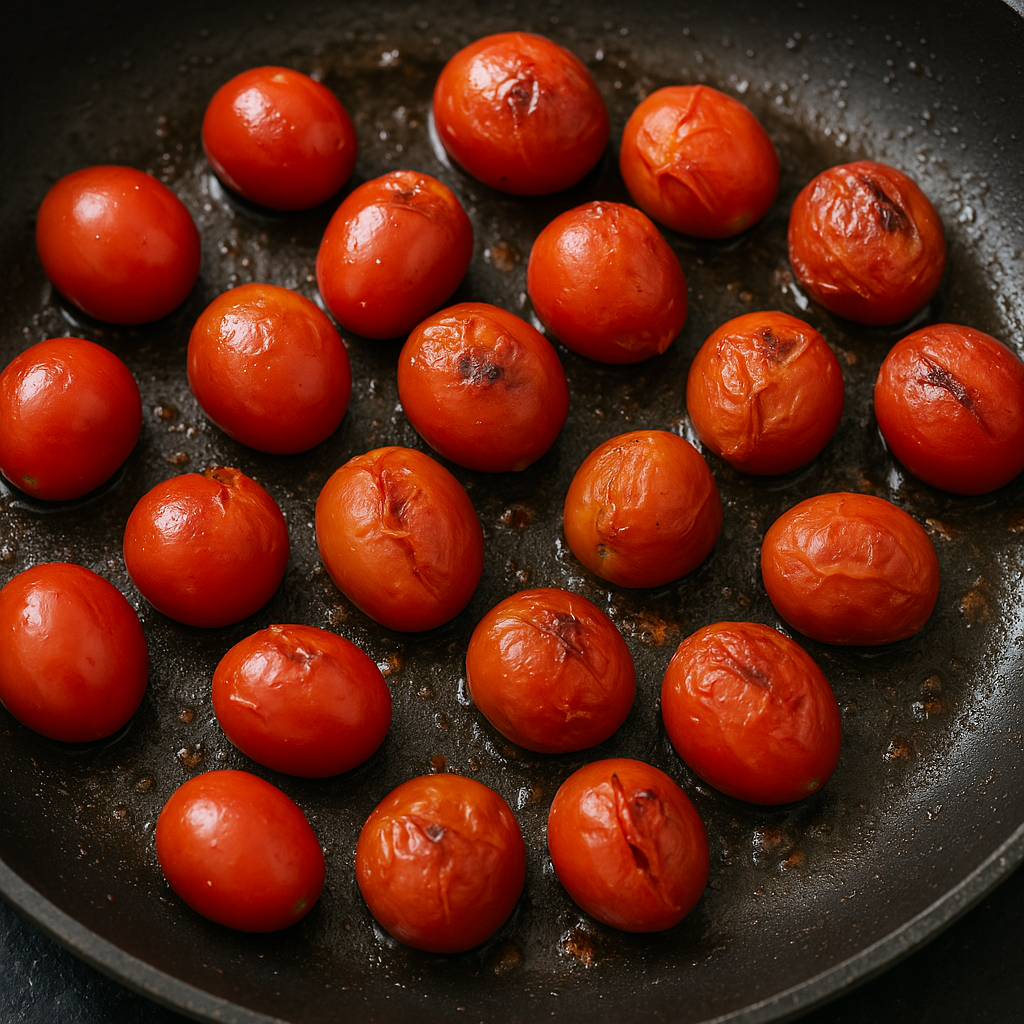Tomatoes are a culinary staple found in cuisines across the globe. While they’re delicious raw, something magical happens when you apply heat to them—especially at high temperatures.
Blistering tomatoes in the oven is a technique that enhances their natural sweetness, brings out a smoky depth, and gives the skin a satisfying, wrinkled texture that bursts with flavor.
This process is both easy and rewarding, making blistered tomatoes a must-have in your cooking toolkit.
Whether you’re looking to top a homemade pizza, layer them onto bruschetta, toss them into a grain bowl, or serve them as a side, this simple roasting method transforms a humble tomato into a show-stopping ingredient.
In this guide, we’ll cover everything you need to know – from choosing the right tomatoes, step-by-step roasting instructions, chef-approved tips, and a range of creative serving ideas. Let’s get started.
Why Do You Need To Oven-Blister Tomatoes
Table of Contents

Blistered tomatoes are more than just visually appealing. The high roasting temperature causes their skins to crack and their juices to concentrate.
The result you get is a sweet, juicy, caramelized bite that retains some of the tomato’s natural acidity but with a deeper, roasted flavor.
Here’s what blistering tomatoes in the oven does:
- Enhances flavor – The heat draws out natural sugars, resulting in a concentrated, sweet-savory profile.
- Improves texture – The skins wrinkle and sometimes char slightly, adding a rustic appearance and delicious texture.
- Adds versatility – Once blistered, tomatoes can be used in a multitude of dishes—hot or cold.
- Reduces waste – Got tomatoes that are just past their prime? Roasting revives their usefulness and enhances their flavor.
What Are The Best Tomato Varieties for Oven Blistering
While most tomatoes can be blistered with some success, the best results come from smaller varieties due to their higher sugar content and lower water content. These include:
Cherry Tomatoes
Cherry tomatoes are small, juicy, and sweet. Perfect for quick roasting and ideal in salads or pasta dishes.
Grape Tomatoes
Slightly firmer and meatier than cherry tomatoes, grape tomatoes hold their shape well during roasting.
Campari Tomatoes
Larger than cherry or grape varieties, but still sweet and juicy. Great if you want slightly larger roasted pieces.
Heirloom or Roma Tomatoes
You can blister Roma and heirloom too, but for even roasting, cut them into wedges. They’ll require a bit more time and may not “burst” in quite the same way.
You can also use a mix of colors for a vibrant, eye-catching final dish.
Essential Ingredients for Making Blistering Tomatoes

Blistering tomatoes in the oven doesn’t require fancy ingredients. In fact, part of what makes this method so accessible is its simplicity. Here’s what you’ll need:
Basic Ingredients
- 1 pint cherry or grape tomatoes
- 1–2 tablespoons olive oil
- Kosher salt, to taste
- Freshly ground black pepper
Optional Flavor Additions
- 2–4 garlic cloves, smashed or sliced
- Fresh herbs – rosemary, thyme, oregano, or basil
- Balsamic vinegar
- Red pepper flakes
These additions can elevate your blistered tomatoes depending on how you plan to use them.
Tools You’ll Need
- Rimmed baking sheet
- Parchment paper or aluminum foil
- Tongs or a spatula
- Oven preheated to 425°F (220°C)
How to Blister Tomatoes in the Oven

Now follow the step-by-step methods to blister tomatoes in oven.
1. Preheat Your Oven
Set your oven to 425°F (220°C). This high heat is essential for quick caramelization and proper blistering. A lower heat may result in steamed, rather than blistered, tomatoes.
2. Wash and Dry the Tomatoes
Rinse your tomatoes under cool water to remove any debris or residue. Dry them thoroughly with a clean kitchen towel or paper-towels. This is a crucial step—excess moisture can cause the tomatoes to steam instead of blister.
3. Season the Tomatoes
Place the dry tomatoes on a rimmed baking sheet. Drizzle with olive oil, and toss gently to coat them evenly. Sprinkle with kosher salt and freshly ground black pepper.
If you’re adding garlic or herbs, toss them in now. For even more depth of flavor, you might add a dash of balsamic vinegar or a sprinkle of red pepper flakes.
If using parchment paper or foil, line your sheet before adding the tomatoes to minimize sticking and cleanup.
4. Roast
Roast the tomatoes on the middle rack for 15 to 20 minutes. You’ll know they’re ready when:
The skins are blistered and beginning to split
Some tomatoes appear slightly shriveled
A few may have charred spots, especially where they touched the pan
You can give the tray a gentle shake or stir halfway through to ensure even roasting.
5. Cool Slightly
Once roasted, remove the tomatoes from the oven and allow them to cool for 5–10 minutes. Be cautious—hot tomatoes can burst when moved immediately.
You can serve them warm, at room temperature, or refrigerate them for later use.
Storage Tips

Refrigerator – Store cooled blistered tomatoes in an airtight container for up to 5 days.
Freezer – Freeze them (without herbs or garlic) in a freezer-safe container for up to 2 months. When thawed, they’ll be soft but great for sauces or stews.
Oil-preserved – Pack them in a jar with olive oil and keep inside the fridge—perfect for antipasto or appetizers.
Creative Ways to Use Blistered Tomatoes

The beauty of blistered tomatoes lies in their versatility. Here are some standout ideas to get you started:
-
Pasta
Toss blistered tomatoes with pasta, olive oil, garlic, fresh basil, and a generous grating of parmesan. Add grilled chicken or shrimp for extra protein.
-
Gourmet Toast
Spoon them over crusty bread with whipped ricotta, goat cheese, or burrata. Drizzle with honey or balsamic glaze for a chef’s kiss finish.
-
Pizza Upgrade
Use them as a topping on homemade or store-bought pizza dough, along with fresh mozzarella, pesto, or roasted garlic.
-
Grain Bowl Goodness
Add them to grain bowls with farro, quinoa, roasted vegetables, and a creamy tahini or lemon dressing.
-
Salad Enhancer
Toss with arugula, shaved parmesan, pine nuts, and a squeeze of lemon. They also pair beautifully with mozzarella and fresh basil in a Caprese-style salad.
-
Warm Dip Topping
Add blistered tomatoes on top of baked feta, hummus, or creamy bean dips for a flavorful contrast.
-
Simple Side Dish
Serve warm as a side with roasted meats, grilled fish, or pan-seared tofu. They pair beautifully with both light and rich main courses.
Why Are My Tomatoes Not Blistering Properly?

You may be using too low a heat or your tomatoes may be too wet. Ensure they’re dry before roasting and that the oven is fully preheated.
You can use a cast iron skillet is especially effective for achieving intense blistering and even browning.
There’s no need to peel off the skin of the tomatoes, unless you’re using the tomatoes in a sauce and want a smoother texture. For most dishes, the skins add a pleasant texture and a rustic look.
You can also add thinly sliced onions, bell peppers, or zucchini roast well alongside blistered tomatoes. Just adjust cooking times accordingly.
Health Benefits of Roasted Tomatoes
Blistered tomatoes aren’t just flavorful—they’re healthy, too. Roasting enhances the availability of lycopene, a powerful antioxidant linked to reduced risk of heart disease and certain cancers. They’re also rich in vitamin C, potassium, and folate.
Wrapping Up
Blistering tomatoes in the oven is one of those satisfying cooking techniques that yields maximum flavor with minimal effort.
In just 20 minutes, you can turn a pint of cherry tomatoes into something special—something with enough depth to stand alone or enough versatility to enrich almost any dish.
So next time you see those ripe tomatoes at the market (or in the back of your fridge), don’t let them go to waste. Roast them. Blister them. And savor the magic they bring to your kitchen.
Leave a Reply